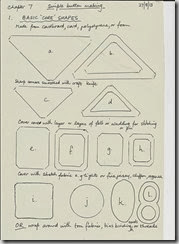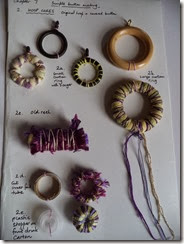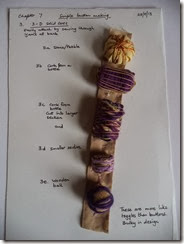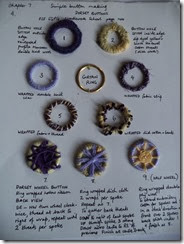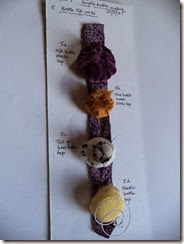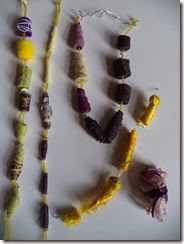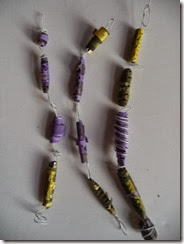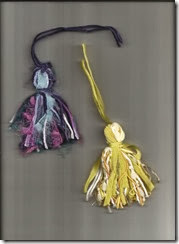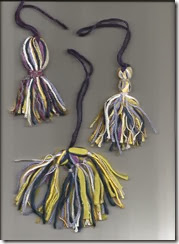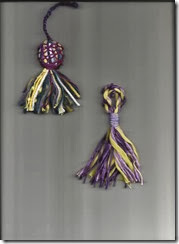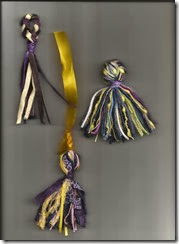This chapter contains a selection of buttons using different cores, techniques and complementary colours of purple and yellow, in hand dyed or commercial fabrics, threads, wires and beads.
There are series of samples
- Basic core shapes
- Hoop cores
- 3-D solid cores
- Dorset buttons
- Bottle top cores
- Toggle buttons
The notebook contains techniques and materials used for each button with Health & Safety rules.
1. Basic core shapes
Commercial fabric was used to add a consistency to the background, varying the design shape and size. Each was wrapped with a first layer of wadding to soften the feel and add depth to the button.
No hollowed examples were made except for hoop cores (See 2 below). It can be more difficult to wrap fabrics and threads through the shapes and around corners, cutting off a bit of each corner helps. They could be used as buckles, brooches or pendants. Some of the techniques used on the hoops could be applied to hollowed shapes.
2. Hooped cores
There are many items that could be used to make these buttons, here are just a few.
I like the combination of colours and tried to use different textures of threads and torn yarns, including some hand dyed materials.
Some can be hung on bags, clothing or used separately as jewellery, with or without extra hoop to hang.
3. 3-D solid cores
Exposed cores of cork or wood might be useful to relate to the musical instrument theme.
I like 3d as it is more delicate and for the combination of commercial and hand-dyed threads.
4. Dorset buttons
I like this technique and can see with a variation in threads or torn yarns quite a variety might be made. 5, 6 and 9 show several spiral applications. These buttons could be added to a number of accessories.
5. Bottle top cores
I had quite a lot of fun with these. Each were initially padded. Circles of stretchy or soft fabrics were used, gathering a circle of running stitch near the edge of the circle of fabric.
The first two were left with fabric only, attaching the button to expose the spiral effect of the gathered fabric.
The other two were embellished with wire and beads or left with the wire showing its spiral effect. (It was important not to have sharp points exposed). They were attached with stitch using the gathered fabric side. I noticed that attaching using the flatter surface made it easier to hold the button in a particular position, the second two had minds of their own!
What a wonderful way for reusing all those bottle tops, hoops and card tubes. Aluminium foil and cling film rolls are especially solid and a good size to cut up.
6. Toggle buttons
I displayed these samples on woollen threads or wire, showing that the buttons can be a string or single and act as buttons or beads.
Left hand samples
The strands from left to right were made of different fabrics: felt, with or without a layer of Lutrador; layers of Lutrador; leather or suede; cut up silk rod and on its own a hand-dyed silk cocoon wrapped with hand dyed silk string and tied with a ribbon.
Each were varying cuts of triangular material, rolled into a button (or bead), attached with PVA glue, and/or wire.
Some buttons were wrapped with wires spiralling around the button.
Right hand samples
These were made of hand painted Tyvek, one side of the Tyvek in shades of yellow, the other side in shades of purple.
The buttons were cut with designs using a soldering iron, especially for use in embroidery work.
I have noticed that I have not used metallic thread with the buttons or used a heat gun. I can imagine the latter producing a bubbled or concave effect dependent on which side of the Tyvek is uppermost.
With most of the toggle buttons I was able to use spirals not only on the buttons but also to join some of them together.
It is very important to use caution with the soldering iron and heat gun and Health and Safety rules are provided in my notes.
As well as the button samples above I also have commercial buttons in the chosen colours and some hand dyed (Chapter 3).
